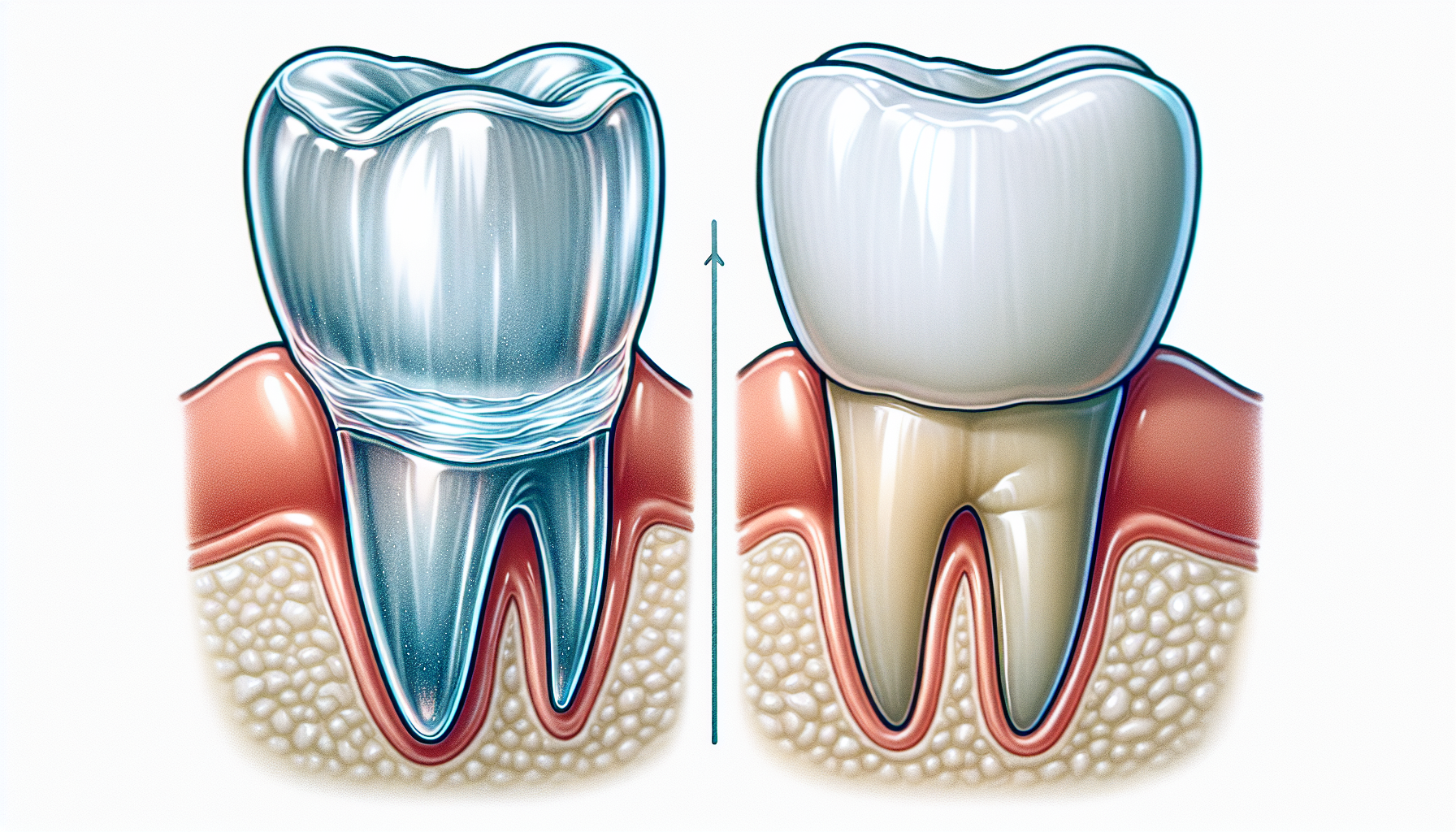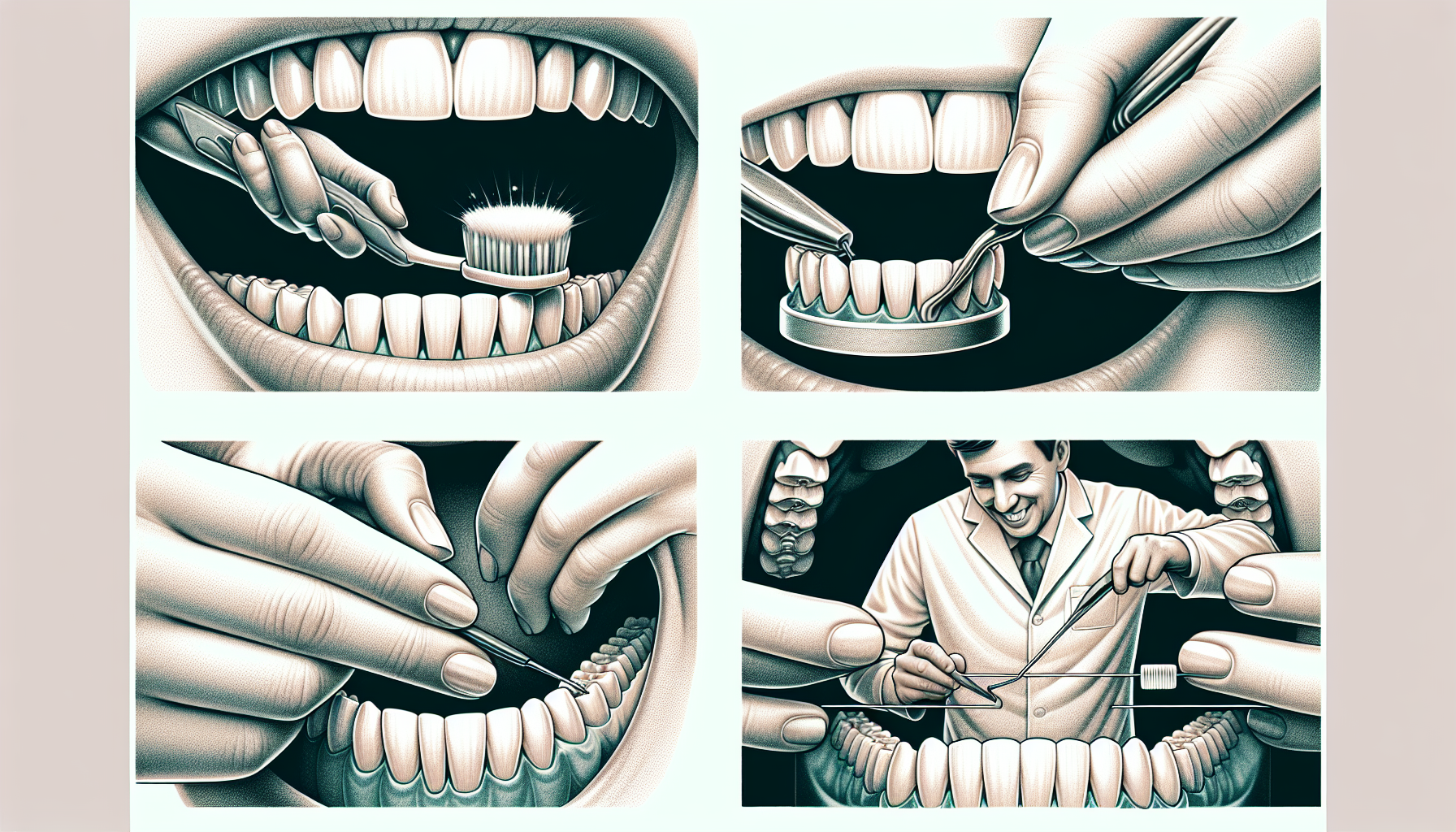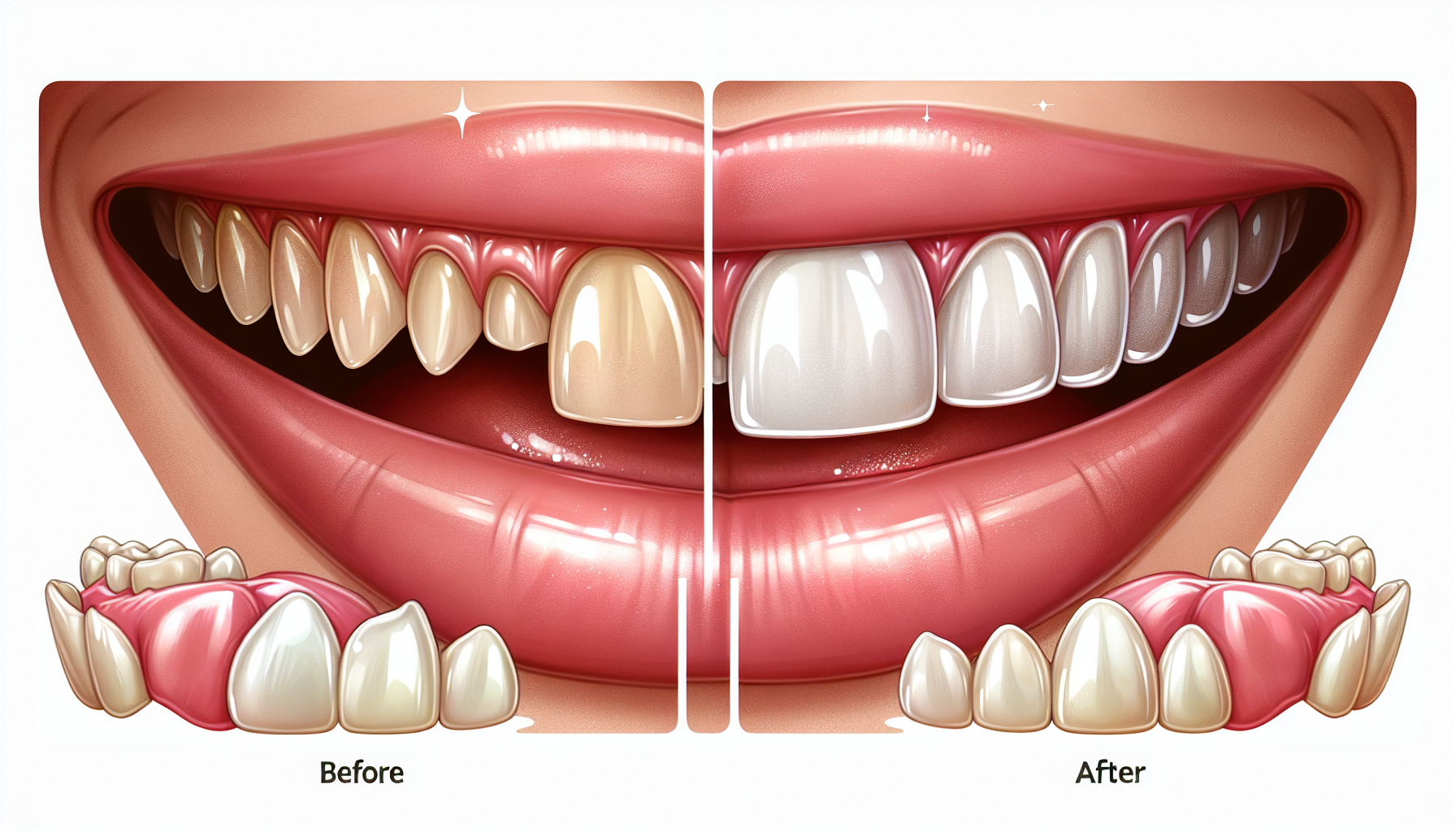If you’re seeking to improve your smile’s appearance, veneers could be the answer.
This article cuts through the complexities, offering you a direct insight into the role veneers play in cosmetic dentistry, the choices available, the application process, and their care.
By understanding these aspects, you’ll be equipped to determine if veneers fit your dental needs.
Key Takeaways
Veneers are custom-designed, thin shells that address various dental imperfections like discoloration, chips, and gaps, enhancing overall smile aesthetics and oral health.
There are multiple veneer types and materials, including porcelain and composite resin, each with distinctive benefits and lifespans, alongside innovative no-prep and removable options.
Proper care extends the longevity of veneers, and the veneer application process involves consultation, tooth preparation, custom creation in a lab, and precise placement to ensure a natural look and fit.
The World of Dental Veneers

Dental veneers, with their transformative power, have revolutionized cosmetic dentistry. They are thin, durable shells made from high-quality dental materials like tooth-colored composite or porcelain.
They serve a significant purpose: to cover the front surface of teeth, thereby significantly improving the aesthetics of a person’s smile. They are not just about looks, though. Quality veneers are built to last, providing a lasting smile makeover.
Defining Dental Veneers
Veneers are not a one-size-fits-all solution; they are custom-designed to address a variety of aesthetic imperfections. Well-designed dental veneers can successfully address a range of issues with front teeth, including:
Discoloration
Wear
Chips
Misalignment
Spacing
Irregular shapes
Yet, the success of a veneer treatment isn’t solely dependent on the veneer, it also requires a conducive environment. Crucially, bonding to enamel is essential for successful treatment, along with the absence of damaging habits such as teeth grinding or clenching.
The survival and effectiveness of a veneer restoration can be greatly enhanced by an incisal overlap preparation design, which provides better support and distributes occlusal forces over a larger area.
Veneers in Cosmetic Dentistry
Veneers offer more than mere cosmetic enhancement; they fundamentally contribute to cosmetic dentistry, frequently chosen as the preferred treatment for enhancing teeth aesthetics. They allow you to redesign and reshape your entire mouth, providing a realistic solution to various aesthetic concerns.
Some benefits of veneers include:
Cosmetic enhancement
Reducing tooth wear
Can be placed on the inside of upper teeth for additional benefits
Gum recession can be effectively managed with proper veneer design, material selection, accurate placement, and good dental hygiene.
The Different Faces of Veneers

The veneer landscape is vast and varied, providing an assortment of types to cater to diverse needs and preferences. Here are some of the different types of veneers available:
Composite veneers
Porcelain veneers
No-prep veneers
Removable veneers
Each type of veneer brings unique properties and benefits to the table. This array of options allows you to choose a veneer type that aligns with your aesthetic goals, dental health, and budget.
The choice of veneer material crucially influences its aesthetics, durability, and interaction with your tooth structure. The most common materials used for dental veneers are porcelain and resin composite, each affecting the tooth structure and aesthetics differently.
Porcelain Veneers vs Composite Resin Veneers
Porcelain and composite resin veneers are the predominant types, each boasting distinct benefits and considerations. Traditional porcelain veneers are known for their high aesthetic results and do not stain as easily as composite resin veneers.
They typically last longer than composite veneers, making them a durable choice for a smile makeover. However, one downside is that significant cracks or damage usually require full replacement due to the nature of porcelain.
On the other hand, composite resin veneers offer an alternative that can be repaired more easily if damaged.
Made from a tooth-colored resin, composite veneers are less extensive restorations compared to custom-made porcelain veneers. They can also be applied in a single visit, providing a good initial aesthetic without the need for multiple dental appointments.
Innovations in Veneers: No-Prep and Removable Options
Dental innovations have spurred advancements in veneer alternatives, offering less invasive and potentially reversible solutions. No-prep veneers, such as Lumineers, can be fitted over existing teeth without extensive preparation, requiring less alteration of the tooth structure.
An even more novel approach is the use of removable veneers, also known as snap-on or pop-on veneers, and temporary veneers.
These non-permanent options are easy for patients to wear over their natural teeth to mask imperfections. However, as with all dental procedures, it’s important to consult with a dental professional to ensure their suitability and safety.
The Veneer Procedure: What to Expect
The application of dental veneers involves several stages, including:
Consultation: Discussing cosmetic dentistry goals and options.
Smile preparation: Preparing the teeth by removing a small amount of enamel.
Designing: Creating a mold or digital impression of the teeth to create custom veneers.
Creation: The veneers are crafted in a dental laboratory.
Placement: The final veneers are bonded to the teeth using dental cement.
This process ensures that the veneers are custom-made to fit your teeth and achieve your desired cosmetic results.
This process isn’t solely about veneer placement, but also involves devising a bespoke treatment plan tailored to your specific dental needs and aesthetic preferences. The aim is to ensure that the end result is a natural, beautiful smile that enhances your confidence and overall persona.
Preparing Your Teeth for Veneers
Tooth preparation constitutes a vital phase in the veneer application process. It involves the removal of a portion of the tooth enamel to allow space for the veneer to fit properly and look natural. However, the amount of enamel removal depends on the type of veneer. For instance, pressed ceramic veneers require a more substantial removal of tooth enamel due to their thicker structure.
In some cases, additional procedures, such as gum contouring, may be necessary to ensure veneers achieve the desired aesthetic and functional results. These procedures contribute to creating an optimal environment for the veneer, ensuring it fits perfectly and blends seamlessly with your natural teeth.
From Dental Lab to Your Smile
Once your teeth are prepared, the journey of your veneers continues in a dental laboratory. Here, impressions of the prepped teeth are used to create a design that perfectly matches your bite and natural tooth appearance. Hand-poured porcelain is often used for making stacked ceramic veneers, ensuring a highly authentic look.
The final step is the precise cementing of the porcelain veneers onto your teeth, followed by fine adjustments to ensure a comfortable and seamless integration with your natural dental structure. This meticulous process ensures that your veneers not only look great but also feel like a natural part of your smile.
Longevity and Care: Making Your Veneers Last

Although veneers are built to be durable and endure over time, their lifespan can be significantly extended by proper care. Proper care and maintenance can extend the lifespan of your veneers, allowing you to enjoy your beautiful smile for longer.
Whether you have porcelain or composite resin veneers, here are some tips to help extend their durability:
Avoid hard foods that can potentially damage your veneers.
Avoid bad habits like nail biting, straw chewing, and using your teeth as tools.
Regularly brush and floss your teeth to maintain good oral hygiene.
Schedule routine dental check-ups to ensure the health of your veneers and overall dental health.
Following these tips will help you maintain your veneers and keep your smile looking great.
The Lifespan of Veneers
The durability of veneers is largely contingent on their type and constituent material. Porcelain veneers are known for their excellent aesthetic results and predictable longevity, with studies showing a 94.4% survival rate after five years and a 93.5% after ten years. However, these rates can vary due to individual dental practices and patient care.
On the other hand, composite veneers typically have less longevity, with a life expectancy ranging from five to ten years and a survival rate of 89% after 5 years. For patients prone to teeth grinding, lithium disilicate, a veneer material option, provides more durability.
Caring for Your Veneers

Appropriate care of your veneers can significantly preserve their appearance and prolong their lifespan. Here are some essential practices for maintaining dental veneers:
Brush two times each day for two minutes.
Floss daily.
Use a soft toothbrush and non-abrasive toothpaste when brushing veneers to avoid scratching their surface.
Flossing should continue as usual even with veneers, supporting overall dental health and veneer longevity. Also, avoid eating very hard foods like almonds or cracking shells with the front veneers to prevent chipping, and refrain from using teeth as tools.
Cost Considerations for veneers
Despite veneers being a valuable investment in your smile, it’s important to factor in the cost. The price can vary based on your location and the number of teeth treated. On average, porcelain veneers cost 790 USD per tooth, while composite veneers range from $350 to $450 per tooth.
It’s important to remember that while cost is a significant consideration, the value that veneers add to your smile and self-esteem is priceless. Veneers are not just about enhancing aesthetics; they are about boosting confidence and improving quality of life.
Understanding the Investment in Veneers
The choice of material significantly impacts the cost of veneers. While options like porcelain are typically more expensive due to their higher quality, they can often provide superior aesthetic results and longevity.
While the cost of veneers is generally calculated per individual tooth, some dental practices may offer discounts or package deals for procedures involving multiple veneers. It’s important to discuss all cost-related aspects with your dentist to ensure you’re making an informed decision.
Addressing Common Concerns with Veneers
Veneers can proficiently address a multitude of cosmetic dental issues. They can effectively cover tooth discoloration that cannot be fixed with teeth whitening. Chipped teeth can be restored to their natural look using veneers, enhancing smile aesthetics.
High satisfaction rates among patients with veneers are reported, as they meet or exceed expectations for aesthetic improvement and function. With proper care, porcelain veneers can last 10-15 years, contributing to their popularity. However, for patients concerned about gum recession, dental professionals can employ precision techniques to ensure the veneer’s margins are properly placed and do not contribute to recession.
Cosmetic Concerns and Veneers

Veneers offer a versatile solution to a wide range of cosmetic dental issues, including:
Discolored teeth
Fractured teeth
Tooth shape irregularities
Minor tooth misalignments
Intraoral repairs of fractured bridge facings
Dental veneers can effectively address these cosmetic issues.
Zirconia veneers provide a robust solution for weakened teeth or those with considerable damage, boasting a high resistance to breakage. These veneers not only restore the structural integrity of the tooth but also improve the overall aesthetic outcome.
Alternatives to Traditional Veneers
Although veneers can provide a transformative remedy for numerous cosmetic dental problems, they might not always be the optimal choice. It’s important to know that there are alternatives to traditional veneers, such as dental crowns and bonding, that might be more appropriate in certain situations.
Dental crowns are custom restorations that cover damaged teeth, requiring the reduction of the original tooth to fit, while also aiming to match the appearance of natural teeth. Dental bonding is a minimally invasive alternative that involves applying, shaping, and hardening composite resin directly onto the teeth with UV light.
For more significant dental alignment problems, orthodontic treatments such as braces or clear aligners like Invisalign may be recommended over veneers.
When Veneers Aren’t the Right Choice
Despite their effectiveness, veneers might not always be the appropriate solution for every individual. Patients with the following conditions are not ideal candidates for dental veneers:
Parafunctional habits
Edge to edge relation
Poor oral hygiene
Insufficient enamel
In cases where teeth are weak or have sustained significant damage, dental crowns may be a better option. They provide both aesthetic and structural benefits as they:
Envelop the entire tooth
Provide comprehensive coverage
Offer a higher level of protection and durability compared to veneers that cover only the front surface of the tooth.
Summary
In essence, dental veneers offer an effective and versatile solution for various cosmetic dental issues.
Whether it’s porcelain or composite, traditional or no-prep, veneers can transform your smile, enhance your confidence, and improve your quality of life.
With proper care and maintenance, they can last for many years, offering great value for the investment. However, it’s essential to consult with a dental professional to ensure that veneers or their alternatives are the right choice for your specific needs.
Frequently Asked Questions
Are veneers a good solution for discolored teeth?
Yes, veneers can effectively cover tooth discoloration that cannot be fixed with teeth whitening. They provide a good solution for discolored teeth.
How long do veneers last?
Porcelain veneers can last 10-15 years with proper care, making them a long-lasting option for improving your smile.
Are there any alternatives to veneers?
Yes, alternatives to traditional veneers include dental crowns and bonding. Crowns are used to cover the entire tooth, while bonding involves applying a tooth-colored resin to the tooth’s surface.
Is the veneer procedure painful?
The veneer procedure is not usually painful because it is performed under local anesthesia, minimizing discomfort.
How do I take care of my veneers?
To take care of your veneers, it’s important to brush and floss regularly and attend routine dental check-ups for overall dental health.


